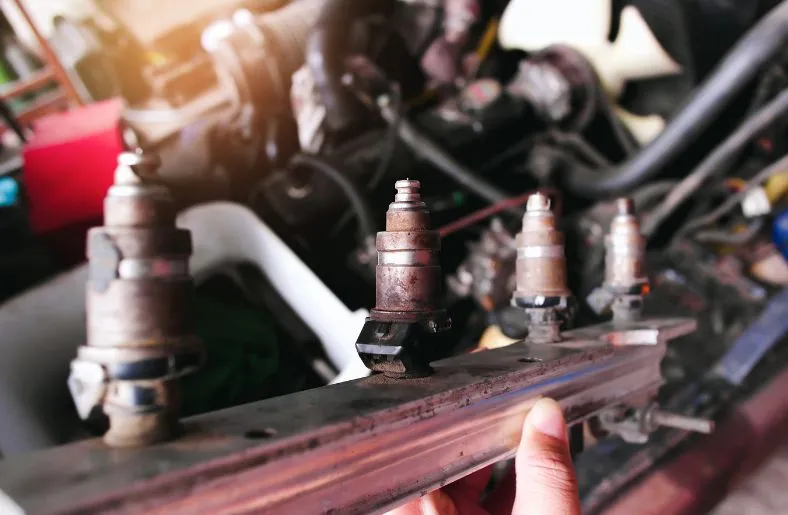Fuel injectors play a critical role in the operation of a vehicle’s engine. They are responsible for delivering the precise amount of fuel into the combustion chamber, ensuring efficient and optimal performance. A leaking fuel injector can lead to a variety of problems, including reduced fuel efficiency, engine misfires, and even engine damage.
In this comprehensive guide, I will walk you through the step-by-step process of how to fix leaking fuel injector, enabling you to restore your vehicle’s performance and save money on costly repairs.
Table of Contents
Signs of a Leaking Fuel Injector
Before moving towards the guide on how to fix leaking fuel injector, it’s important to be able to identify the signs of a leaking fuel injector. Some common indicators include:
- Strong fuel smell: If you notice a strong odor of gasoline coming from your vehicle, it could be a sign of a leaking fuel injector. This smell is usually more prominent when the engine is running.
- Engine misfires: A leaking fuel injector can cause the engine to misfire, resulting in a rough idle, hesitation, or loss of power. These issues may occur consistently or intermittently.
- Decreased fuel efficiency: If you find that you’re filling up your gas tank more frequently than usual, it could be due to a leaking fuel injector. The excess fuel leaking into the combustion chamber leads to poor fuel economy.
- Engine performance issues: A leaking fuel injector can cause the engine to run poorly, leading to a lack of acceleration, decreased power, or even stalling.
If you notice any of these signs, it’s important to address the issue promptly to prevent further damage to your vehicle.
How to Fix Leaking Fuel Injector: Step-by-Step
Diagnosing a Leaking Fuel Injector
Diagnosing a leaking fuel injector requires a systematic approach. Follow these steps to identify the faulty injector:
- Visual inspection: Start by inspecting the fuel injector for any visible signs of leakage. Look for fuel stains or wetness around the injector or fuel rail.
- Fuel pressure test: Use a fuel pressure gauge to check the pressure of the fuel system. A significant pressure drop could indicate a leaking fuel injector.
- Fuel injector balance test: This test involves monitoring the injector’s electrical signals to ensure they are all functioning properly. Any irregularities may indicate a leaking injector.
By following these steps, you can pinpoint the specific fuel injector that is causing the leak and proceed with the repair process on how to fix leaking fuel injector.
Tools and Materials Needed
Before diving into the repair process following the guide on how to fix leaking fuel injector, gather the necessary tools and materials. Here’s a list of what you’ll need:
- Safety gear: Always prioritize safety. Make sure to have gloves, safety glasses, and a fire extinguisher nearby.
- Socket set: A socket set will be essential for removing and reinstalling components during the repair process.
- Fuel pressure gauge: This tool is necessary for testing the fuel pressure before and after the repair.
- Injector cleaning kit: A specialized cleaning kit will help remove any debris or deposits from the fuel injector.
- Replacement parts: Depending on the condition of the fuel injector, you may need to replace O-rings, seals, or the entire injector.
Gathering these tools and materials beforehand will ensure a smooth and efficient repair process.
Preparing the Vehicle for the Repair Process
Before starting the repair process by following the guide on how to fix leaking fuel injector, it’s crucial to properly prepare the vehicle. Here’s what you need to do:
- Disconnect the battery: Start by disconnecting the vehicle’s battery to ensure your safety and prevent any electrical mishaps during the repair.
- Relieve fuel pressure: Locate the fuel pump fuse or relay and remove it to relieve the fuel pressure in the system. This step is essential to prevent any fuel spraying or leaks during the repair.
- Depressurize the fuel system: Start the engine and let it run until it stalls. This will empty the fuel lines and remove any remaining pressure in the system.
By following these steps, you will ensure a safe and controlled environment for the repair process on how to fix leaking fuel injector.
Removing the Leaking Fuel Injector
Now that the vehicle is prepped, it’s time to remove the leaking fuel injector. Follow these steps:
- Locate the fuel rail: The fuel rail is where the fuel injectors are attached. It’s usually located on top of the engine.
- Disconnect electrical connections: Remove any electrical connections attached to the fuel rail or fuel injector. This may include clips or plugs.
- Remove the fuel rail: Loosen the mounting bolts or clips holding the fuel rail in place. Gently lift the rail to access the fuel injectors.
- Detach the fuel injector: Carefully disconnect the fuel injector from the fuel rail by removing the retaining clip or bolt.
By following these steps, you will successfully remove the leaking fuel injector from your vehicle.
Cleaning the Fuel Injector and Its Components
Once the leaking fuel injector is removed, it’s essential to clean it and its components thoroughly. Here’s how to do it:
- Inspect for debris: Examine the fuel injector for any visible debris or deposits. Use a magnifying glass if necessary.
- Use a cleaning solution: Dip the fuel injector in a specialized cleaning solution or use an injector cleaning kit to remove any clogs or deposits.
- Clean the fuel rail: While the fuel injector is soaking, clean the fuel rail using the same cleaning solution. This will ensure optimal fuel flow.
- Inspect O-rings and seals: Check the O-rings and seals for any signs of wear or damage. Replace them if necessary to prevent future leaks.
By following these cleaning steps, you will restore the fuel injector to its optimal condition.
Replacing Damaged or Worn-Out Parts
During the cleaning process, you may discover damaged or worn-out parts that need replacement. Here’s what you should do:
- Inspect the fuel injector: Examine the fuel injector carefully for any signs of damage or wear. Pay particular attention to the nozzle and electrical connections.
- Replace damaged parts: If you notice any damaged or worn-out parts, such as a cracked nozzle or faulty electrical connection, replace them with new ones.
- Replace O-rings and seals: If the O-rings or seals are worn or damaged, replace them with new ones to ensure a proper seal and prevent future leaks.
By replacing any damaged or worn-out parts, you will ensure the longevity and effectiveness of the repaired fuel injector.
Related Guide: Squeaky Suspension Fix: Silencing the Creaks for a Smooth Ride (2024)? Expert Guide
Reinstalling the Repaired Fuel Injector
With the fuel injector cleaned and any necessary parts replaced, it’s time to reinstall it. Follow these steps:
- Attach the fuel injector to the fuel rail: Carefully place the repaired fuel injector back into the fuel rail and secure it with the retaining clip or bolt.
- Reinstall the fuel rail: Place the fuel rail back onto the engine, aligning it with the mounting bolts or clips. Tighten them securely.
- Reconnect electrical connections: Attach any electrical connections that were previously disconnected, ensuring a secure and tight connection.
By following these steps, you will successfully reinstall the repaired fuel injector.
Testing the Fuel Injector and Checking for Leaks
After reinstalling the fuel injector, it’s crucial to test it and check for any potential leaks. Here’s what you should do:
- Reconnect the battery: Reconnect the vehicle’s battery to restore power to the fuel injector and electrical components.
- Turn on the ignition: Turn the ignition key to the “on” position without starting the engine. This will pressurize the fuel system.
- Check for leaks: Inspect the fuel injector and the surrounding area for any signs of leaks. Look for fuel stains or wetness.
- Perform a fuel pressure test: Use a fuel pressure gauge to test the pressure of the fuel system. Compare the readings to the specifications outlined in your vehicle’s manual.
By performing these tests, you can ensure that the repaired fuel injector is functioning properly and there are no leaks present.
Prevention Tips to Avoid Future Fuel Injector Leaks
To prevent future fuel injector leaks, follow these essential tips:
- Use high-quality fuel: Always use high-quality fuel that meets the manufacturer’s recommendations. Low-quality fuel can leave deposits and cause injector clogs.
- Regularly clean the fuel system: Periodically clean the fuel system using a specialized cleaning solution or additives to prevent the buildup of deposits.
- Replace fuel filters: Regularly replace the fuel filters as recommended by the vehicle’s manufacturer. This will ensure that any contaminants are filtered out before reaching the fuel injectors.
By following these prevention tips, you can prolong the lifespan of your fuel injectors and avoid potential leaks.
Conclusion
Fixing a leaking fuel injector is a critical task that requires careful attention to detail and the use of proper tools and materials. By following this step-by-step guide on how to fix leaking fuel injector, you can confidently diagnose and repair a leaking fuel injector, restoring your vehicle’s performance and efficiency. Remember to prioritize safety throughout the process, and consult a professional if you encounter any difficulties. With proper maintenance and preventive measures, you can avoid future fuel injector leaks and enjoy a smooth-running engine.
Now that you have the knowledge and tools to fix a leaking fuel injector, it’s time to put them into practice. Take the necessary steps to diagnose and repair any issues with your fuel injectors, and enjoy the benefits of improved engine performance and fuel efficiency.

